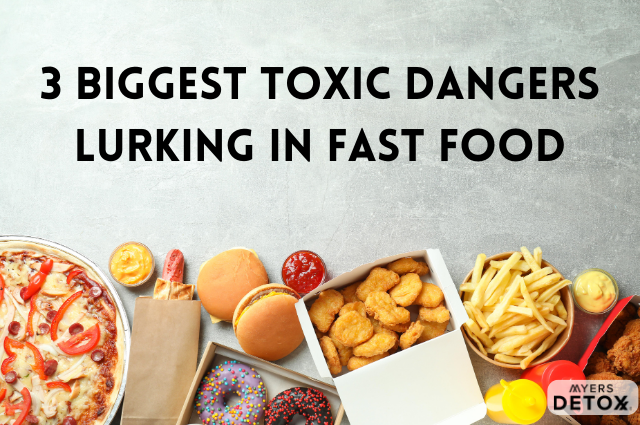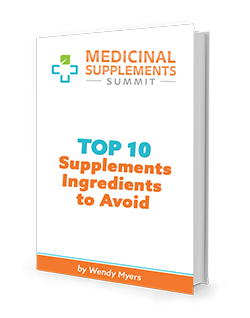Fast food is a staple of the American diet, with around one-third of our population consuming fast food every day (at least once per day)[1].
While it would likely come as no surprise if I told you that fast food was not as nutritious as whole food options, what you may not know is that the dangers of fast food come down to something much greater than a lack of nutrient density.
Aside from the additives, highly processed ingredients, vegetable oils, and excess sugar, fast food is riddled with toxic compounds that have gone under the radar for years.
Moms Across America, a non-profit group focused on empowering moms to create healthier homes and communities, took it upon themselves to survey the toxic load in the top fast food brands in the US – and the results were startling.
In this article, we’ll examine what their reports found, but before we jump in, here are just a handful of highlights:
- 100% of fast food samples contained alarming levels of heavy metals
- 100% of samples contained the toxic herbicide glyphosate
- School lunch samples contained heavy metals at 6,293 times higher than the EPA’s maximum levels allowed in drinking water.
- 80% of the fast food meals tested included veterinary drugs (antibiotics or hormones)
3 Toxic Dangers Hiding In Your Fast Food

The research conducted by Moms Across America found numerous toxic compounds in common fast food meals, but for simplicity’s sake, we’ll break them down into three categories:
- Heavy metals
- Pesticides and herbicides
- Veterinary antibiotics and hormones
Among the fast food restaurants tested were some of the most popular chains, including Mcdonald’s, Wendy’s, Taco Bell, Domino, Chick-fil-A, Starbucks, and Dunkin Donuts.
1. Heavy Metals
Heavy metals exist naturally in our earth’s crust but have found their way into our food, water, and personal care supply at alarming rates. And as it turns out, fast food may significantly contribute to our dietary intake of these toxic compounds.
According to MAA, 100% of the fast food samples tested contained alarming levels of lead and cadmium, with around 93% containing detectable levels of arsenic[2][3].
Perhaps most concerning is that the levels of lead in the samples tested were nearly five times the U.S. Food and Drug Administration’s (FDA) daily maximum for children.
Furthermore, The U.S. Environmental Protection Agency (EPA) warns that no amount of lead exposure is safe, especially for children, as it can cause lifelong damage to children’s IQ[4].
Studies show that lead can cause damage to the nervous system, slowing development and growth and resulting in speech and learning problems in children[5].
And while much of the research around lead has been focused on its effects on children, this heavy metal can also significantly impact adult health. In severe cases, high levels of lead can cause hypertension and issues with the kidneys, brain, and reproductive system[6].
Cadmium is another highly concerning metal that can cause multiple organ system toxicity. Specifically, chronic cadmium exposure can affect kidney function, cause issues in the musculoskeletal system like osteomalacia (softening of the bones), and may produce parkinsonism, a neurological disorder that closely resembles Parkinson’s disease[7].
The levels of cadmium tested were between 74%-1158% higher than what the EPA allows in drinking water. And that 1158% came from no other than the popular West Coast “healthier” fast food restaurant In-And-Out Burger.
And then, of course, there’s arsenic, a known carcinogen with toxic effects that can impact every organ system[8]. While around 93% of samples tested had some amount of arsenic, the worst offender was Panda Express’s orange chicken and white rice, with 362% higher levels than what the EPA allows in drinking water.
Unfortunately, many fast food chains are the primary suppliers of school lunches. When MAA looked into heavy metals in school lunches, they found levels of heavy metals up to 6,293 times higher than the EPA’s maximum levels allowed in drinking water[9].
Simply put, our school lunch programs are doing an abysmal job of nourishing our nation’s youth.
2. Pesticides and Herbicides
MAA found that 100% of the samples tested positive for glyphosate, a toxic herbicide, and 90% tested positive for other harmful pesticides.
Pesticides and herbicides are widely used in almost all conventional farms to enhance yield and keep bugs and other small predators away. Unfortunately, these compounds that are meant to enhance the abundance of our food supply are incredibly toxic to our bodies.
Let’s start with glyphosate, one of the most controversial and harmful herbicides still widely used today.
Glyphosate is specifically used on GMO crops, as this herbicide keeps predators away while allowing the crops to grow as usual. This should be our first red flag. But the real dangers of glyphosate come down to its impact on human health. Studies show that this chemical can be linked to several serious health issues, including neurotoxicity, metabolic disease, non-alcoholic fatty liver disease (NAFLD), non-hodgkin’s lymphoma, disrupted gut health, and more[10][11][12].
There is some concern about the increasing use of glyphosate and mood disorders like anxiety and depression, particularly in children. Due to their small body size, any amount of toxicity is going to impact them more than adults, and it’s interesting that as the use of glyphosate has increased, so too has mood disorder in both the adult and children populations[13][14].
Glyphosate is known to have toxic effects on the gut, targeting beneficial gut bacteria and allowing for the proliferation of harmful gut bugs that can disrupt the gut-brain axis. The downstream effects could be widespread, impacting everything from sleeping behaviors to mood to hormonal health[15].
In addition to glyphosate, several pesticides were also found in the fast food samples (90%, to be exact.) Of the 27 different pesticides sampled, several fast foods contained as many as nine, with the highest levels found in foods from Domino’s and Pizza Hut[16].
Much like glyphosate, pesticides come with some serious side effects. In fact, animal studies show that pesticide exposure can cause[17]:
- Headaches
- Muscle twitching
- Damage to developing fetus
- Tremors
- Confusion
- Trouble with balance and coordination
- Dizziness
- Weakness
- Tightness in the chest
- Sweating
- Nausea
- Respiratory disease
- Eye and skin irritation
- Coma
- Death
- And more
From this list, it’s clear that pesticides can impact every organ system in the body with varying symptoms.
When MAA looked at glyphosate and pesticides in school lunches, they found that 95% of school lunches tested had detectable levels of glyphosate, and 75% tested positive for harmful pesticides[18].
3. Veterinary Antibiotics and Hormones
MAA found that 80% of the fast food meals tested included varying levels of veterinary drugs, specifically antibiotics and hormones[19].
Why would we find such a high percentage of these drugs in fast food?
Fast food chains purchase their meat from factory farmers who use conventional farming methods. This means lots of animals are in small, confined spaces. These extremely close quarters are often unsanitary, which produces a high level of disease among the animals. These concentrated animal feeding operations (CAFOs) rely on drugs like antibiotics and antiparasitics to keep their animals alive and ward off mass infection. Thus, veterinary drugs are routinely used in their practices.
While these drugs may do the job of keeping the animals alive and “healthy,” they become dangerous to human health when we consume meat from conventionally raised animals.
In their report, MAA found that 60% of the tested samples contained an antibiotic called Monensin. Monensin is an animal antibiotic that is not approved for human use due to its potentially fatal side effects. Poisoning with this drug can result in a range of health concerns, including difficulty breathing, loss of appetite, loss of balance and coordination, nerve damage and muscular weakness, muscle breakdown, inadequate oxygenation of blood, diarrhea, and itching[20][21].
While levels of Monensin varied between samples, some were shockingly high. For example, one Wendy’s cheeseburger contains 1.53 mcg, while the “acceptable” daily intake is 5 mcg/kg per day.
Another antibiotic, Narasin, was found in 40% of the fast food samples. Side effects of Narasin in animals include loss of appetite, diarrhea, labored breathing, depression, loss of coordination and balance, and death[22]. Pathologically, Narasin is known to cause degeneration and necrosis of the heart and skeletal muscles.
Both Monensin and Narasin are toxic to dogs and horses and can cause paralysis of the hind legs at extremely low levels. MAA raised the question that if these medications are sneaking into the human diet, could they be one of the culprits behind the rising rates of conditions like restless leg syndrome and neuropathy? It certainly seems likely.
In addition to antibiotics, the MMA study also found high levels of Nicarbazin, an antiparasitic drug that impacts hormonal health. This drug is used as a contraceptive in fowl, causing infertility in fowl such as pigeons and geese to control animal populations[23].
Beyond the Toxins, Another Danger of Fast Food Is Its Nutrient Deficiency
Now that we’ve covered the hidden toxins in fast food, it’s time to explore the other side of the coin: what does the nutritional content of fast foods look like?
Unsurprisingly, most fast food meals come up short in nutrients, and given that many of these foods are used as the basis for school lunches, this is a massive issue. While adults certainly need a healthy smattering of nutrients each day, school-aged children, whose bodies and brains are still growing and developing, rely heavily on nutrients in their food.
In their report, essential minerals such as calcium, potassium, manganese, copper, zinc, and iron were well below the RDI (recommended daily intake). However, in a shocking revelation, MAA found zero levels of vitamins B9 and B12 in the top fast food meals surveyed[24].
Why is this information so shocking?
Vitamin B12 is naturally abundant in foods like beef and chicken – two staples of most fast food meals. Which leaves us wondering, where did all of the B12 go?
On a more practical note, the lack of b vitamins in these meals raises concern for general health and wellness as these nutrients play a role in a wide range of physiological activities, including nervous system function, cardiovascular health, energy metabolism, digestion, and many more[25][26].
B vitamins also play a crucial role in mental health. In fact, research shows that both vitamin B12 and B9 deficiencies could be linked to increased rates of depression and anxiety[27][28].
With so many people relying on fast food as a source of nutrition, it’s no wonder we’re facing the mental health challenges that we are today.
But B12 and B9 weren’t the only vitamins deficient in fast food. In fact, the levels of vitamin B3 were so low that MMA pointed out that for an adult woman to meet the USDA recommended daily intake of 14 mg of Vitamin B3, she would need to consume 333 Chick-fil-A chicken sandwiches.
Again, vitamin B3 is not a nutrient that’s hard to come by in whole foods, which means that fast food processing is somehow managing to reduce the nutrient content of foods while simultaneously increasing the toxic load.
The Alternative: Real Food for Real Health
What can you do if fast food has been a staple in your life?
While it may be convenient, the downfalls of fast food are far from worth it. Yes, fast food may provide a cost-effective meal, but the NIH reports that America’s poor diet habits drive $50 billion a year in healthcare costs[29]. And you can bet that McDonald’s isn’t footing the bill for that one.
If you’re looking for the healthiest option, making your own food at home will always be the best choice. When you cook fresh foods for yourself, you avoid unwanted additives and preservatives, and you can choose your ingredients from organic farmers who avoid herbicides like glyphosate and feed their animals as they’re meant to be fed instead of pumping them full of antibiotics and hormones.
If you simply don’t have the time to cook, there are meal delivery services that focus on high-quality foods, so you could consider looking for one of these options in your area. You may also find that cooking in bulk takes care of the convenience issue. Many people choose to cook their meals for the week on a Sunday, so they don’t have to think about it. FYI: chicken will stay good for five days in the refrigerator, and beef will stay good for seven.
In addition to avoiding fast food, however, there is another crucial step to take if fast food has been a part of your diet for a while – and that’s cleansing. These toxins found in fast foods are insidious, and they’ll stick around in your body for years (some for decades). By assisting your body in releasing stuck toxins like heavy metals, glyphosate, and veterinary drugs, you’ll slowly relieve yourself of your toxic burden, and I assure you, the results will feel remarkable.
Many people who have been consuming fast food for most of their lives don’t even know what it feels like to feel good. They become so accustomed to feeling mediocre that it becomes their new normal – and that’s no way to live.
My go-to for everyday gentle cleansing is Daily Detox. This powder is full of nutrients that support your natural detoxification pathways, and while gentle, it’s a powerful formula for clearing your body of unwanted compounds. It’s also incredibly simple to take; just one scoop in the morning, and you’re good for the day.
Takeaway
The overarching issue here isn’t only the fact that many common fast food meals contain these toxic chemicals, but the safety levels of these compounds are only really meaningful in terms of poisoning; they don’t protect against everyday buildup that can happen when you frequently consume fast foods, as many people do.
In other words, the FDA’s limits may prevent acute poisoning, but they don’t do anything to protect us against the chronic low-level poisoning that takes place when we regularly consume fast food.
And of course, it’s not only what’s in the food that’s concerning, but also what’s lacking. Sure, you could consume a fast food burger once a week without falling into a deep nutrient deficit, but if fast food items are a regular part of your diet, this lack of nutrients can build up over time, just like the toxic load.
While groups like Moms Across America are doing their part to bring awareness to these issues, the onus is on each of us to vote with our dollar and ensure that we’re giving our bodies (and our children’s bodies) what we need to stay healthy and strong.
*These statements have not been reviewed by the FDA. Daily Detox is a dietary supplement and is not intended to diagnose, treat, cure, or prevent any disease. It is not intended to replace any medication or healing modality prescribed by your medical doctor. Please consult with your doctor before beginning a new supplement regimen.











